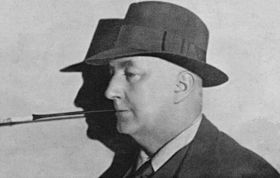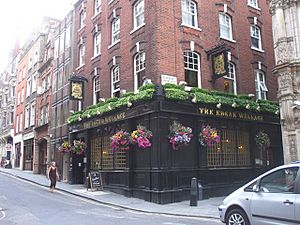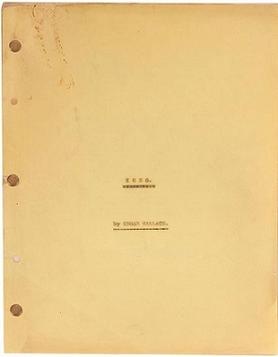Edgar Wallace facts for kids
Quick facts for kids
Edgar Wallace
|
|
|---|---|
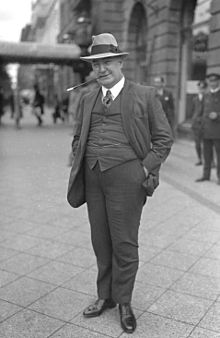
Wallace in 1928
|
|
| Born |
Richard Horatio Edgar Wallace
1 April 1875 |
| Died | 10 February 1932 (aged 56) |
| Nationality | British |
| Occupation | Crime writer, war correspondent, journalist, novelist, screenwriter, and playwright |
| Known for | Creation of King Kong |
| Spouse(s) |
Ivy Maude Caldecott
(m. 1901; div. 1918)Ethel Violet King
(m. 1921) |
Edgar Wallace (born April 1, 1875 – died February 10, 1932) was a super-fast British writer. He wrote many thrilling stories.
Edgar Wallace was born in London into a poor family. He left school when he was only 12 years old. At 21, he joined the army. He became a war correspondent, reporting from wars for newspapers like Reuters and the Daily Mail.
After facing money problems, he started writing exciting thrillers. One of his first popular books was The Four Just Men (1905). He also wrote adventure stories like Sanders of the River (1911). These stories were inspired by his time reporting from Africa.
Wallace became a very famous author. He was so quick at writing that one publisher said he wrote a quarter of all books in England! He wrote over 170 novels, many plays, and hundreds of short stories. More than 160 films have been made from his books.
He is especially remembered for helping create the story for the famous movie King Kong. He also wrote popular detective stories about a character called J. G. Reeder. Even today, many of his books are still read in Germany.
Contents
Edgar Wallace's Early Life
Family Background
Edgar Wallace came from a family of entertainers. His great-grandfather was a performer named James Henry Marriott. His grandmother, Alice Marriott, was an actress. Edgar was born in Greenwich, England. His parents, Richard Edgar and Mary Jane Richards, were both actors.
Edgar's mother worked in the theatre. She met and joined the Marriott family's acting group. When she found out she was going to have a baby, she found a place to stay. She asked her midwife to find a family to care for her child.
Childhood and First Jobs
On April 9, 1875, Edgar's mother took him to the Freeman family. Mrs. Freeman already had ten children. Her husband, George Freeman, was a fishmonger. Edgar, then known as Richard Horatio Edgar Freeman, had a happy childhood. He felt very close to Clara Freeman, who was like a second mother to him.
By 1878, his birth mother could no longer pay the Freemans. Instead of sending him to a workhouse, the Freemans adopted him. His birth mother never visited him again as a child. George Freeman wanted Edgar to get a good education. Edgar went to a boarding school for a while. But he often skipped school and left full-time education at age 12.
As a teenager, Edgar had many different jobs. He sold newspapers, delivered milk, and worked in a rubber factory. He also worked in a shoe shop and as a ship's cook. A special plaque in London marks where he first sold newspapers. He was fired from his milk delivery job for taking money.
In 1894, he joined the British Army. He registered under the name Edgar Wallace, inspired by the author of Ben-Hur. He was sent to South Africa in 1896. He didn't like army life much. He managed to switch to the Press Corps, which he enjoyed more.
Becoming a Writer and Journalist
Reporting and First Books
Edgar Wallace started writing songs and poems. He was inspired by the famous writer Rudyard Kipling, whom he met in South Africa in 1898. His first book of poems, The Mission that Failed!, came out that same year. In 1899, he left the army to become a full-time writer.
He stayed in Africa and became a war correspondent. He reported on the Second Boer War for Reuters and the Daily Mail.
In 1901, Edgar married Ivy Maude Caldecott in South Africa. Her father, a missionary, did not approve of the marriage. Their first child, Eleanor, sadly died in 1903. The couple then moved back to London. They were deeply in debt.
In London, Wallace worked for the Daily Mail. He started writing detective stories to earn money quickly. His son, Bryan Edgar Wallace, was born in 1904. His daughter, Patricia, was born in 1908. In 1903, Wallace met his birth mother, Polly, for the first time. She was very ill and poor. He turned her away, and she died later that year.
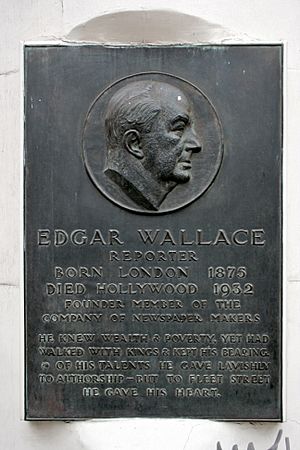
Publishing Challenges
Wallace couldn't find anyone to publish his first book. So, he started his own company, Tallis Press. He published his thriller The Four Just Men (1905). Even though the book sold well, he managed his money poorly. The owner of the Daily Mail had to help him out.
Things got worse when Wallace's reporting had mistakes. This led to lawsuits against the Daily Mail. Wallace was fired in 1907. No other newspaper would hire him because of his reputation. His family was almost always broke. His wife, Ivy, even had to sell her jewelry for food.
In 1907, Edgar traveled to the Congo Free State. He reported on the terrible things happening there under King Leopold II of Belgium. A magazine asked him to write stories based on his experiences. These stories became his first collection, Sanders of the River (1911). It was a bestseller and later became a film. He wrote 11 more collections of these adventure stories. He sold the rights to his first 28 books and their films for quick cash.
Success and Spending
From 1908 to 1932, Wallace wrote a huge number of books. At first, he wrote to pay off his debts. But his books became very successful. He started reporting on horse racing. He wrote for different papers and even started his own racing papers. He bought many racehorses himself.
He lost thousands of pounds gambling. Even with his success, he spent a lot of money on a fancy lifestyle he couldn't afford. In 1916, Ivy had their third child, Michael. She filed for divorce in 1918.
Later Life and Achievements
New Beginnings
Ivy moved away with the children. Wallace became closer to his secretary, Ethel Violet King. They married in 1921. Their daughter, Margaret Penelope June (Penny), was born in 1923.
Wallace started taking his fiction writing more seriously. He signed a big contract with publishers Hodder and Stoughton in 1921. This gave him money in advance and royalties from his books. The publisher promoted him as a celebrity writer, the "King of Thrillers." He was known for his special hat, cigarette holder, and yellow Rolls-Royce.
People said he could write a 70,000-word novel in just three days! He could even work on three novels at once. In 1928, it was thought that one out of every four books read in the UK was written by Wallace. He wrote many types of stories, including science fiction and screenplays. He also wrote a ten-volume history of the First World War. In total, he wrote over 170 novels, 18 plays, and 957 short stories. His works were translated into 28 languages.
Wallace was the chairman of the London Press Club. This club still gives an annual Edgar Wallace Award for great writing. He also became chairman of the British Lion Film Corporation. This gave him a big salary and a share of the company's profits. By 1929, Wallace was earning almost £50,000 a year. That's like £2 million today!
Writing Style and Innovations
Edgar Wallace was the first British crime novelist to use policemen as the main characters. Most other writers at the time used amateur detectives. Many of his novels are stand-alone stories. He didn't often use the same heroes in a series.
On June 6, 1923, Edgar Wallace made history. He became the first British radio sports reporter. He reported on The Derby horse race for the new British Broadcasting Company (BBC).
Personal Challenges and Politics
Wallace's ex-wife, Ivy, was diagnosed with breast cancer in 1923. She died in 1926.
Wallace became involved in politics with the Liberal Party. He ran for election in Blackpool in 1931. He supported free trade. He also bought a newspaper, the Sunday News, and edited it for six months. But he lost the election by a lot of votes.
He moved to America in November 1931, still carrying a lot of debt. He wrote the screenplay for the first sound film of The Hound of the Baskervilles (1932).
In Hollywood, Wallace worked as a "script doctor" for RKO. This meant he helped fix movie scripts. He wanted his own stories to become films. So he adapted books like The Four Just Men. His play On the Spot, about gangster Al Capone, was a huge success. It helped start the career of actor Charles Laughton.
Edgar Wallace's Death and Legacy
His Final Days
In December 1931, Wallace started working on a "gorilla picture" for RKO. This film would become the classic King Kong (1933). By late January, he began having severe headaches. He was diagnosed with diabetes. His health quickly got worse.
Edgar Wallace died on February 10, 1932, in Beverly Hills, California. He died from diabetes combined with double pneumonia. Flags on newspaper offices in London flew at half-mast to honor him. His body was returned to England and buried in Little Marlow Cemetery.
After His Death
Even though he was very successful, Wallace had a lot of debt. Some of it was from his early years in South Africa. But the large royalties from his popular books helped pay off all his debts within two years.
Sadly, Violet Wallace, his second wife, died only 14 months after him. She was just 33 years old.
His Lasting Impact
Violet Wallace left her share of Edgar's estate to their daughter, Penelope (1923–1997). Penelope also became an author of mystery novels. She and her husband managed her father's literary works. They started the Edgar Wallace Society in 1969. This society still has members in 20 countries.
Wallace's oldest son, Bryan Edgar Wallace (1904–1971), also became a mystery writer. In 1934, Bryan married Margaret Lane, who wrote a biography of Edgar Wallace in 1938.
The Edgar Wallace Mystery Magazine was a monthly magazine. It published crime and detective stories from 1964 to 1967. It included stories by Wallace and other famous authors like Agatha Christie.
More than 160 films and many radio shows have been made from Wallace's work. There is even a pub named after him in London!
How Edgar Wallace Wrote
His Unique Method
Edgar Wallace had a very interesting way of writing. He would speak his stories into wax cylinders. These were like the dictaphones of his time. Then, his secretaries would type up what he said. This might be why he could write so quickly. It also made his stories feel very fast-paced.
Many of his successful books were dictated in just two or three days. He would lock himself away with lots of cigarettes and sweet tea. He often worked for 72 hours almost non-stop. Most of his novels were first published in parts in magazines. But they were written in this quick way.
Wallace rarely edited his work after it was typed. He sent it straight to the publishers. He really disliked having others revise his writing. The publishers would only do quick checks for mistakes before printing.
Some people accused him of using "ghost writers" (people who write for someone else). But there is no proof of this. His amazing speed became a bit of a joke. Wallace himself said he didn't think his books had great literary value.
Science Fiction Stories
Edgar Wallace enjoyed writing science fiction. But he didn't make much money from it. He always needed income, so he went back to writing thrillers that sold easily.
One of his science fiction short stories is Planetoid 127 (1924). It's about a scientist on Earth who talks to someone on a "mirror Earth." This other Earth orbits on the opposite side of the Sun, so we can't see it. The idea of a "mirror Earth" later became a common idea in science fiction.
His other science fiction works include The Green Rust. This story is about terrorists who want to destroy the world's corn crops. 1925 correctly predicted a short peace followed by a German attack on England. The Black Grippe is about a disease that makes everyone blind. His most famous science fiction work is the screenplay for King Kong.
Creating King Kong
Out of all the scripts Wallace wrote for RKO, the "gorilla picture" had the biggest impact. It became the classic movie King Kong (1933).
Wallace wrote the first draft of the script in five weeks. He called it "The Beast" at first. He later suggested "King Ape" as a title. His 110-page script was just the first rough version. It was not the final script for filming.
After Wallace died, other writers, Ruth Rose and James Ashmore Creelman, worked on the script. They took Wallace's ideas and made them ready for the movie. Rose added the opening scenes that introduce the characters and plot. They reworked Wallace's original script to make sure it worked well on screen.
Popularity in Germany
In 1959, a Danish company started making movies based on Wallace's books in West Germany. These movies were very popular. They made 38 more films until 1972. Wallace's son, Bryan, also had 10 of his novels made into movies there. These films were set in the UK but filmed in Germany. Even though critics didn't always love them, the movies gained many fans.
In 2004, a German comedian made a movie called Der Wixxer. It was a tribute to the old black and white Wallace movies. It was very popular, and a sequel was made in 2007.
More of Wallace's books are still printed in Germany than anywhere else. His work has always been very popular there.
Edgar Wallace's Books
African Novels (Sanders of the River series)
- Sanders of the River (1911)
- The People of the River (1911)
- The River of Stars (1913)
- Bosambo of the River (1914)
- Bones (1915)
- The Keepers of the King's Peace (1917)
- Lieutenant Bones (1918)
- Bones in London (1921)
- Sandi the Kingmaker (1922)
- Bones of the River (1923)
- Sanders (1926)
- Again Sanders (1928)
Four Just Men Series
- The Four Just Men (1905)
- The Council of Justice (1908)
- The Just Men of Cordova (1917)
- The Law of the Four Just Men (1921)
- The Three Just Men (1925)
- Again the Three (1928)
Mr. J. G. Reeder Series
- Room 13 (1924)
- The Mind of Mr. J. G. Reeder (1925)
- Terror Keep (1927)
- Red Aces (1929)
- The Crook in Crimson (1929)
- The Guv'nor and Other Short Stories (1932)
Detective Sgt. (Insp.) Elk Series
- The Nine Bears (1910)
- The Fellowship of the Frog (1925)
- The Joker (1926)
- The Twister (1928)
- The India-Rubber Men (1929)
- White Face (1930)
Educated Evans Series
- Educated Evans (1924)
- More Educated Evans (1926)
- Good Evans (1927)
Smithy Series
- Smithy (1905)
- Smithy Abroad (1909)
- Smithy and The Hun (1915)
- Nobby (1916)
Other Novels
- Captain Tatham of Tatham Island (1909)
- The Duke in the Suburbs (1909)
- Private Selby (1912)
- "1925" – The Story of a Fatal Peace (1915)
- Those Folk of Bulboro (1918)
- Tam o' the Scoots (1918)
- The Book of All Power (1921)
- The Flying Fifty-Five (1922)
- The Books of Bart (1923)
- Barbara on Her Own (1926)
Poetry Collections
- The Mission That Failed (1898)
- War and Other Poems (1900)
- Writ In Barracks (1900)
Non-fiction
- Unofficial Despatches of the Anglo-Boer War (1901)
- Famous Scottish Regiments (1914)
- Field Marshal Sir John French (1914)
- Heroes All: Gallant Deeds of the War (1914)
- The Standard History of the War (1914)
- Kitchener's Army and the Territorial Forces (1915)
- War of the Nations (1915-1917)
- Famous Men and Battles of the British Empire (1917)
- The Real Shell-Man (1919)
- People or Edgar Wallace by Himself (1926)
- The Trial of Patrick Herbert Mahon (1928)
- My Hollywood Diary (1932)
Plays
- An African Millionaire (1904)
- The Forest of Happy Dreams (1910)
- Dolly Cutting Herself (1911)
- The Manager's Dream (1914)
- M'Lady (1921)
- The Mystery of room 45 (1926)
- Double Dan (1927)
- A Perfect Gentleman (1927)
- The Terror (1927)
- Traitors Gate (1927)
- The Lad (1928)
- The Man Who Changed His Name (1928)
- The Squeaker (1928)
- The Calendar (1929)
- Persons Unknown (1929)
- The Ringer (1929)
- The Mouthpiece (1930)
- On the Spot (1930)
- Smoky Cell (1930)
- The Squeaker (1930)
- To Oblige A Lady (1930)
- The Case of the Frightened Lady (1931)
- The Old Man (1931)
- The Green Pack (1932)
- The Table (1932)
Screenplays
- The Valley of Ghosts (1928)
- Mark of the Frog (1928)
- Prince Gabby (1929)
- The Squeaker (1930)
- The Hound of the Baskervilles (1932)
- King Kong (1932, first draft)
Short Story Collections
- P.C. Lee (1909)
- The Admirable Carfew (1914)
- The Adventures of Heine (1917)
- Tam O' the Scouts (1918)
- The Man Called McGinnice (1918)
- The Fighting Scouts (1919)
- The Black Grippe (1920)
- Chick (1923)
- Elegant Edward (1924)
- The Exploits of Airman Hay (1924)
- The Black Avons (1925)
- The Brigand (1927)
- The Mixer (1927)
- This England (1927)
- The Orator (1928)
- The Thief in the Night (1928)
- The Lone House Mystery and Other Stories (1929)
- The Governor of Chi-Foo (1929)
- Again the Ringer (1929)
- The Big Four (1929)
- The Black (1929)
- The Cat-Burglar (1929)
- Circumstantial Evidence (1929)
- Fighting Snub Reilly (1929)
- For Information Received (1929)
- Forty-Eight Short Stories (1929)
- Planetoid 127 and The Sweizer Pump (1929)
- The Ghost of Down Hill & The Queen of Sheba's Belt (1929)
- The Iron Grip (1929)
- The Lady of Little Hell (1929)
- The Little Green Man (1929)
- The Prison-Breakers (1929)
- The Reporter (1929)
- Killer Kay (1930)
- Mrs William Jones and Bill (1930)
- The Stretelli Case and Other Mystery Stories (1930)
- The Terror (1930)
- The Lady Called Nita (1930)
- Sergeant Sir Peter (1932)
- The Scotland Yard Book of Edgar Wallace (1932)
- The Steward (1932)
- Nig-Nog And Other Humorous Stories (1934)
- The Last Adventure (1934)
- The Woman From the East (1934)
- The Edgar Wallace Reader of Mystery and Adventure (1943)
- The Undisclosed Client (1963)
- The Man Who Married His Cook (1976)
- The Death Room: Strange and Startling Stories (1986)
- The Sooper and Others (1984)
- Stories collected in the Death Room (1986)
- Winning Colours: The Selected Racing Writings of Edgar Wallace (1991)
Other Works
- King Kong, with Draycott M. Dell, (1933 posthumously)
See also
 In Spanish: Edgar Wallace para niños
In Spanish: Edgar Wallace para niños


